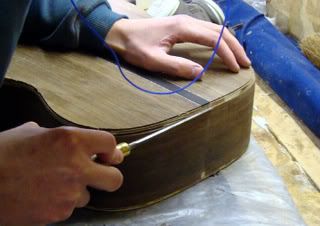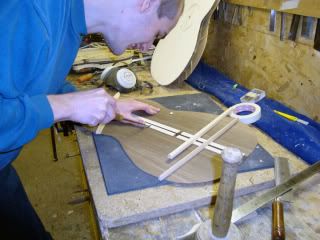Blog by UK acoustic guitarist, author and journalist David Mead covering all things guitar-related
Visit my website: www.DavidMead.net
Tuesday, 30 December 2008
X Rated
Tuesday, 23 December 2008
Dreaming Of A Fylde Christmas...

This picture shows the bindings in place around the perimeter of the body... Which means that this stage of construction is pretty much complete and the next step is to apply the first of around a dozen coats of lacquer.

After a thorough sanding, the body is now placed in the spraying area to await its first coat...

This next shot was taken after the initial coat of lacquer had been applied - you can see from the picture that this has darkened the rosewood down a little - and that it's beginning to look like a real guitar!

The body will now be hand-sanded between subsequent sprayings - Roger tells me that the final coat is left for up to 12 days to harden thoroughly before being buffed to the famous Fylde mirror finish.
So while all that is going on, work starts on the neck. This begins as a single piece of Honduras mahogany which is sliced into three sections before some black lamination is inserted - then it's glued back together.

Once the glue is completely dry, the channel for the truss rod is carved out...

And there we leave it for now. If you're interested in having your own guitar built for you at Fylde - or would like to be kept abreast of developments with the company, why not hike on over to their website at www.fyldeguitars.com and sign up for the email newsletter. Alternatively, take a look around the site - there are bags more pics to look at and many more details regarding how all the instruments are built.
Finally, if you own a Fylde and you've moved since you bought it, drop Roger an email via the site and let him know your new address.
Wednesday, 10 December 2008
Going Bespoke IV
In any case, our latest batch of pics starts pretty much where the last lot left off; we'd got to the stage where the slots for the guitar's inlays around the soundhole had been cut - and here they are being filled in.

The bracing on the underside of a guitar's soundboard is there for two principle reasons: firstly to add strength and secondly to influence the way in which the top vibrates as this has a great effect on the sound of the guitar. Each maker has his own formula for bracing - here we see the classic X brace (pioneered by the Martin guitar company) surrounded by Roger Bucknall's own tried and tested formula for producing a solid, rich tone from the soundboard.

The back of the guitar receives some bracing, too. Two centre reinforcing strips along the 'seam' or joint in the bookmatching, plus horizontal braces to add strength.

Now it's time to begin putting the various elements we've seen constructed together. Here, bracing is being added to the guitar's sides - once again, this is for strength, in order to make the 'box section' of the guitar sturdy enough to withstand the various slings and arrows that we musicians inflict on our treasured instruments!

Once the various components of the guitar's soundbox are ready for final assembly, the top and back are both test fitted to the sides to ensure a good fit. Here, the back is being scrutinised before gluing:

The final stage before the body is finally glued together - test fitting the top:

I'm hugely indebted to Roger Bucknall at Fylde Guitars for sending me these pictures. As many musicians know, it's possible to form a very special bond with an instrument and these images will ensure that I will literally know this acoustic guitar inside and out!
Thursday, 4 December 2008
Going Bespoke III



Thursday, 27 November 2008
Play (Virtually) Anything
Wednesday, 19 November 2008
My Day In The Sun
Wednesday, 12 November 2008
Going Bespoke (Part II)

This particular Rio is quite legal and fully licensed - I mention this because I don't want Greenpeace kicking the door down in a morning raid, thinking I've breached some sort of international agreement with Brazil.
So why choose the more expensive option of Rio for the guitar's back and sides? Well, basically it was because my ears told me to. Let me explain... On a standard Fylde Falstaff the back and sides are made from carefully selected Indian Rosewood. This particular wood is very good at its job of providing a sturdy 'box' to support the guitar's more flexible spruce soundboard and I was quite prepared to have it on mine... Until, that is, I played an instrument with Rio back and sides.
Wednesday, 5 November 2008
Going Bespoke

Tuesday, 28 October 2008
Does Not Contain Plant Extract?
Monday, 20 October 2008
My Life As A Porn Star
Monday, 6 October 2008
BBC's 'Story Of The Guitar'
Last night's show was a bit long-winded on the history front, I thought. Yeah, it's fascinating that you can trace the history of the guitar back to stone carvings thousands of years old - albeit in a severely prototypical form - but does anyone really care?
Wednesday, 17 September 2008
A Metallica Moment
Monday, 15 September 2008
Cheltenham Unplugged
Monday, 1 September 2008
Hey Nonny - No!
This is something that would have probably wounded me deeply a few years ago because it would have conjured up visions of the heavily clichéd folkie - all fingers in ears, beards, baggy jumpers, real ale and 't'was early one morning' and that's definitely not me, my dears.
But have you heard any modern folk recently? I've been taking a listen and have had any illusions I may have had tested to the limit. It seems to me that the umbrella term 'world music' has now opened up to embrace the fringes of what we might call 'experimental folk' and has created a wonderfully expansive landscape for any adventurous musician looking for a place to call home. As examples of this I'll cite Eliza Carthy's new CD 'Dreams Of Breathing Under Water' and the work Simon Emmerson is doing with his Imagined Village project, which marries up such diverse talents as Martin Carthy, Billy Bragg and Benjamin Zephaniah. Both represent an exciting, rich hybrid of diverse musical forms and are simply light years away from what you might imagine.
So I'd like to thank my accuser and say that it might just be an honour to be referred to as being a part of what appears to be a very fertile and lively musical form.
